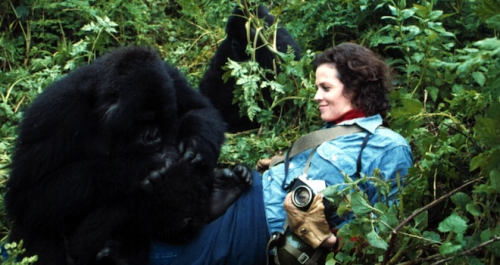Gorillas in the Mist : 25 Things You Didn't Know about the film
03/10/2013
Gorillas in the Mist is a 1988 American drama film directed by Michael Apted and starring Sigourney Weaver as naturalist Dian Fossey. It tells the true-life story of her work in Rwanda with Mountain Gorillas and was nominated for five Academy Awards.
By Gary Susman
But as familiar as Fossey's story is (thanks to the movie), there's still much that remains shrouded in mystery, from the identity of Fossey's killer to how Sigourney Weaver was able to ingratiate herself with Fossey's own gorillas during the filming. Here's the details behind the film, including the hardships involved in making it, which gorillas were fake, and what became of the poacher-threatened primates after the movie crew left.
1. Producer Arne Glimcher and Universal had acquired the movie rights to "Gorillas in the Mist," Fossey's 1983 best-selling memoir. Glimcher traveled to Rwanda in 1985 to meet her and discuss ideas for the movie. Hours before their scheduled meeting, Fossey was murdered by a machete-wielding assailant. She was 53.
2. Warner Bros. planned a rival project about Fossey, based on a Life magazine article about her written by Harold Hayes. After legal wrangling between the two studios, a co-production was arranged and a script was written drawing upon both Fossey's autobiography and Hayes' article.
3. Director Michael Apted is known for shooting movies in remote, mountainous locations. Besides "Gorillas," they include "Coal Miner's Daughter," "Continental Divide," "Thunderheart," "Nell," and "The World Is Not Enough."
4. Much of the shoot took place at the Karisoke Research Center, founded by Fossey, where she worked and observed her gorillas. The crew had to hike to the site -- located 12,000 feet above sea level on an extinct volcano in Rwanda -- every day from a base camp at 8,500 feet, enduring temperatures below 40 degrees, carrying their gear on their backs, and traveling through thick vegetation and mudslides.
5. Weaver once tried to befriend a female gorilla, only to be threatened by a 400-pound male. The actress assumed a submissive position, and the male gorilla passed her by. He turned out to be Pablo, one of the gorillas Fossey had studied, and he earned himself a role on screen.
6. Weaver wore an earpiece so that the filmmakers could tell her what to do as she approached the gorillas. That allowed her to get remarkably close without the film crew disturbing the primates.
7. Having grown accustomed to humans after years spent under Fossey's observation, the gorillas soon became accustomed to Weaver, who learned the gestures and belching grunts Fossey had used to communicate with them. "I've been with them so much that they forgot I was a stranger," she told the New York Times.
8. For all the hours spent hiking each way from the base camp, government restrictions limited the crew to filming the gorillas for only an hour a day.
9. Government restrictions on the number of people who may visit the gorilla area at any given time meant that Weaver was accompanied by a crew of just five.
10. Though only a few could hike to the shoot each day, the base camp housed some 200 crew members and actors in tents.
11. Also at the camp were Rwandan park rangers, armed with rifles to protect against lion attacks.
12. Director Apted edited the film largely in his head, since there were no facilities at the camp to develop the negatives.
13. Producer Terence Clegg had also filmed "Out of Africa" in Kenya and "Cry Freedom" in Zimbabwe, but he found "Gorillas" to be his most difficult African production. The reason: the Rwandan base camp had no telephones or postal service. Clegg hired some 400 Rwandans as porters to bring parcels and messages up and down the mountain.
14. Some of the gorilla footage, involving scenes of animals appearing injured or dying, was done with actors in suits. Monster make-up whiz Rick Baker, known for his work on "An American Werewolf in London" and Michael Jackson's "Thriller," made the suits. Apted was satisfied that the costumes helped the actors blend seamlessly with the real gorillas.
15. According to film critic David Denby, who interviewed Weaver at the time of the film's release, she wore dental templates to exaggerate her jaw in the later scenes where Fossey wreaks horrific vengeance on suspected poachers. "Dian's anger was so cold -- a cold blue flame," Weaver told Denby. "By the end, in the scenes before she's murdered, I felt I was on a roll. Everything had built toward the end, and I felt I could let go."
you can read the whole article on Moviefone : HERE
A découvrir aussi
- Rwanda a haven for nature lovers
- Les beautés du Rwanda
- Adventure in the midst of the gorillas of Rwanda

